We interrupt your Open Durham browsing with advocacy alert from Preservation Durham, 1/23/2025:
The Durham Athletic Park (DAP) is owned by the City of Durham. In 2024, the city hired Perkins & Will to assess the potential future uses of the facility in a way that best benefits the community. As an underutilized historic venue and outdoor space, Preservation Durham is excited about the opportunity to transform the historic ballpark into a lively, public outdoor venue downtown, while preserving its history and its importance to Durham. It is still unclear whether the city prioritizes preserving the ballpark.
The city’s timeline for this project includes three phases: (1) data collection and community input; (2) shaping the vision; and (3) finalizing the plan. You can help influence the future of this site by participating in the community input process. Complete the city’s survey by February 28, 2025, and attend an information session. More details and links can be found on the city’s website here: https://www.durhamnc.gov/5357/Durham-Athletic-Park-Feasibility-Study
What does preservation mean for DAP? The park is a contributing property within the Foster and West Geer Streets National Register Historic District. Key features of the original 1939 structure—including the ticket booth, concession stand, and field—are integral to its historical character and should be preserved as part of any adaptive reuse.
We are confident that with thoughtful, respectful reuse—incorporating modern upgrades in creative ways—DAP can once again become a vibrant downtown destination.
Now back to regular Open Durham browsing!
El Toro Baseball Field, circa 1930. The Jack Tar/Washington Duke Hotel is in the left background.
(Courtesy Duke Rare Book and Manuscript Collection)
Despite the preeminence of basketball in North Carolina today, baseball seems to be far more tightly woven into Durham's DNA.
Local baseball teams were formed in Durham as early as the 1870s - in 1875, the "Eno Bottom Rangers" of Hillsborough played against the "Durham Base Ball Club." Jean Anderson notes that the early games were a bit of a free-for-all. One Durham player evidently died after a game against Hillsborough's team from a combination of too much "redeye whiskey and sun".
Baseball games were a common local pastime, with a bevy of non-professional teams. Across from Maplewood Cemetery (which itself almost became a baseball field) - in the area that I imagine is now the modern portion of the cemetery, the first night baseball games were played in what was then called the "George Lyon Ball Park." Wyatt Dixon chronicles the first such game as "a team of Indians opposing a local team" and reports that the local press derided the event the next day. Other accounts note that the first electric streetcar ride was timed to bring people to a baseball game at the Lyon Park (although the electricity failed, compelling the operators to seek horses to draw the streetcar for the remaining distance.
The history of the Durham Bulls seems to have as many versions as there are sources - I've tried my best to summarize the most consistent elements.
By 1901 several local businessmen affiliated with the Durham Athletic Association attempted to pull together a team to play in the Virginia-Carolina league (or perhaps the Class C North Carolina League.) It seems that by 1902, a "Durham Bulls" team was established. The Durham Bulls' website inconsistently refers to this early team as the "Tobacconists" or the Bulls. The team evidently played on the Trinity College field - at the north end of what is now Duke's East Campus. The team had disappeared again by July of that same year.
City baseball, however, continued to thrive. By 1907, the Durham Hosiery Mill had fielded a baseball team comprised of employees, and in 1909 the Durham Traction Company built a ballpark on North Driver Street, at the later site of East Durham Junior High School. Special streetcars would take people out the East Durham route - down E. Main to Angier, east on Angier to S. Driver, north on Driver to the ballpark. (The streetcar then continued north to Holloway, and west on Holloway to Mangum.) By 1910, a Durham city league was established, with teams from the Hosiery Mill, the YMCA, East Durham, and West Durham.
In 1913, a more successful attempt to establish professional baseball in Durham was undertaken. That year, the North Carolina League was re-formed, and the local team was again named the "Durham Bulls" - a Class D farm team for the Cincinnati Reds. The Bulls played in the East Durham ballpark as well.
Bulls at the East Durham Ballpark, 1913.
From "Baseball's Hometown Teams: The Story of the Minor Leagues" by Bruce Chadwick
The games were interrupted for World War I, and then the league disbanded.
The Piedmont League was established in 1919, and the Bulls were one of the members. The Bulls were successful, and in 1926, private funds were raised to build a new ballpark for the club closer to downtown, on open land near Corporation and Morris Streets. The $160,000 facility was known as El Toro Ballpark. The first game was played at El Toro on July 7, 1926.
El Toro Ballpark, looking northeast, late 1920s
(Courtesy Durham County Library)
In 1930, the Bulls won the Piedmont league, but the financial backers of the park were struggling in the Depression. John Sprunt Hill gave the city $20,000 in funds to buy the park in 1933 with the stipulation that, were it ever sold, the funds should be used to buy additional land for recreation. El Toro Park was renamed Durham Athletic Park.
El Toro Baseball Park, 1930s.
(Courtesy Duke Rare Book and Manuscript Collection)
From 1932 to the 1940s, Durham was the headquarters of the National Association of Professional Baseball Leagues. In 1932, the Bulls became a farm team for the Phillies. In 1933, the Bulls became a farm team for the Yankees, but by 1934 the Bulls had folded due to the Depression. In 1936, the Wilmington Piedmont League team, a Cincinnati Reds farm team, moved to Durham, and was renamed the "Durham Bulls."
On June 17, 1939, the original stadium burned to the ground. The city hired George Watts Carr to design a new ballpark, again paid for by John Sprunt Hill. The result was the present Durham Athletic Park, with its signature conical tower at the entrance. The wooden structure of the original ballpark was replaced with concrete and steel.
View of the stands from near first base, with the fire tower in the background ~1940s.
From "Baseball's Hometown Teams: The Story of the Minor Leagues" by Bruce Chadwick
By 1940, the team had become a farm team for the Brooklyn Dodgers. World War II put a strain on baseball leagues, and the team folded again in 1944. In 1945, the Bulls were re-established as a Red Sox Farm Club in the Class C Carolina League. By 1948, they had switched over to the Detroit Tigers.
Durham Athletic Park from West Geer, late 1940s.
(Courtesy The Herald-Sun Newspaper)
Durham Athletic Park from Corporation St., looking northwest, late 1940s.
(Courtesy The Herald-Sun Newspaper)
I didn't realize until I had interviewed Ralph Rogers and Nick Galifianakis that the DAP was used as the football stadium by Durham High School, at least during some portion of the 1930s-1950s. They related how the school would parade every Friday from their campus, through downtown / Five Points, and up to the stadium. I'm not sure when they stopped playing football here, but perhaps when the Durham County Stadium was built in 1960.
Interest in baseball slowly waned over the 1950s and 1960s. In 1962, the Bulls became a farm club for the expansion Houston Colt .45s. Attendance figures were poor enough that, in 1968, the Raleigh and Durham teams merged, becoming the Raleigh-Durham Mets.
Durham Athletic Park at the time of the Anti-Poverty March, 05.16.68.
(Courtesy The Herald-Sun Newspaper)
Durham Athletic Park at the time of the Anti-Poverty March, 05.16.68.
(Courtesy The Herald-Sun Newspaper)
They split home games between the Durham Athletic Park and Raleigh's Devereaux Meadow. In 1970, the combined team was renamed "The Triangles" (inspired, eh) and folded in 1971.
No baseball was played in Durham until 1980, when Miles Wolff developed an expansion franchise in the Carolina League - farm team for the Atlanta Braves named, once again, the Durham Bulls.
The Bulls developed a following once again, and attendance grew each year. The 1988 movie "Bull Durham" made the Bulls one of the, if not the most recognizable minor league franchise.
1990 (Duke Chanticleer)
But the success of the Bulls nearly took them away from Durham again. As I've detailed previously, the 'deterioration' of the Durham Athletic Park had prompted calls for a new facility, and the city made plans to build a new stadium on the University Ford Site downtown. The 1990 referendum failed to pass, in no small part due to strong editorializing by Jim Goodman, who had acquired an option to purchase the team and wanted to move the Bulls to a more RBC Center-like location near the airport. Nowhere, but a more equidistant car ride from all the actual places in the Triangle. History is mute as to whether he would have renamed the Bulls "The Triangles."
Fortunately, the city made a strong and, at the time, controversial choice to build a new ballpark anyway, on a former American Tobacco parking lot to the east of American Tobacco.
The DAP during the 1993 Season - their last at the DAP
(Courtesy Simon Griffiths
This was completed in 1995, and the Bulls moved to their new stadium (the Durham Bulls Athletic Park, or DBAP,) that year; they became an AAA franchise in 1998.
The Durham Athletic Park has hosted its share of events and baseball games since them - semi-pro teams, the Durham Dragons Softball teams, events like the Blues Festival and Beer Fest. During that time, the facility's need for renovation has grown, and the city has responded by allocating bond money for renovations. Struever Bros. Eccles & Rouse responded to a request for proposals to renovate the park, and hired D'Agostino Izzo Quirk Architects (who renovated Fenway Park in Boston) to oversee the design. NCCU has discussed using the field as the home field for their expansion into Division One baseball. In addition, discussion with Minor League Baseball about bringing a "fan experience museum" to the area around the DAP seems to be ongoing. Who knows what structures will need be sacrificed for the fan experience.
Although I definitely enjoy an occasional baseball game at the DBAP, I must admit that I miss the Bulls at the DAP. My first experiences seeing the Bulls - as a college student around 1991-1992 - were at the DAP. It had an incredibly convivial feel to it - although I'm sure it didn't meet the aspirations of owners and branding types who realized their vision in the current DBAP, the DAP had loads of charm. You certainly felt like you would run into people you knew, and the ground-level look-out-at-the-neighborhood bleachers made you feel like you still had a connection to the Durham around you.
The entrance, from Washington and Corporation, 06.06.08. (Photo by Gary Kueber)
The outfield, from West Geer looking south, 06.06.08 (Photo by Gary Kueber)
The DAP during one "throwback" game at the old park, 05.09.11 (Photo by Gary Kueber)
05.30.11 (Photo by Gary Kueber)


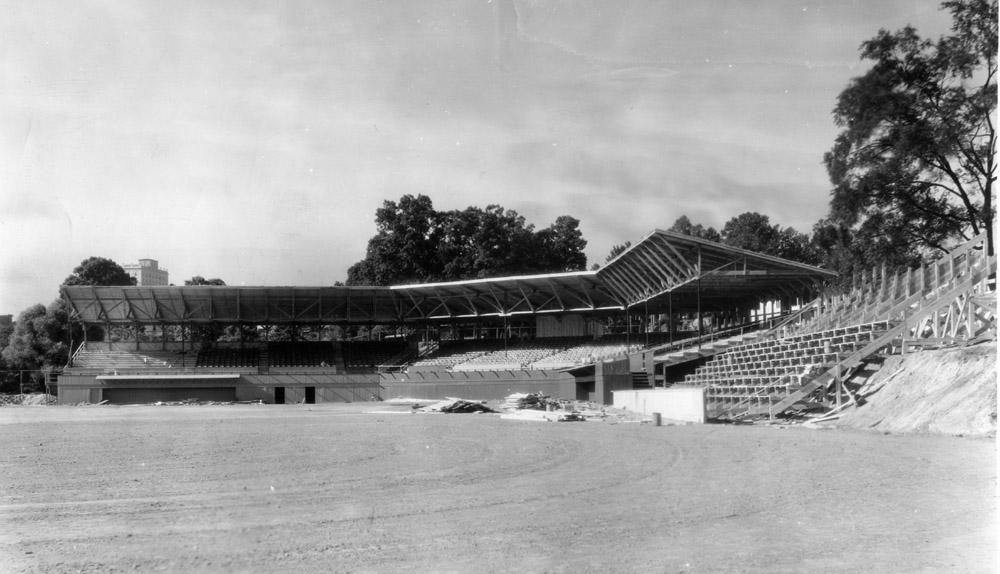
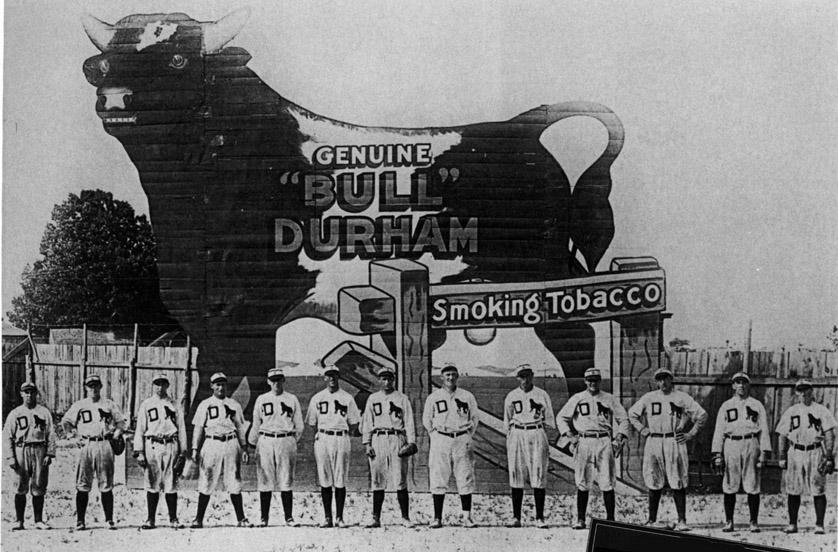
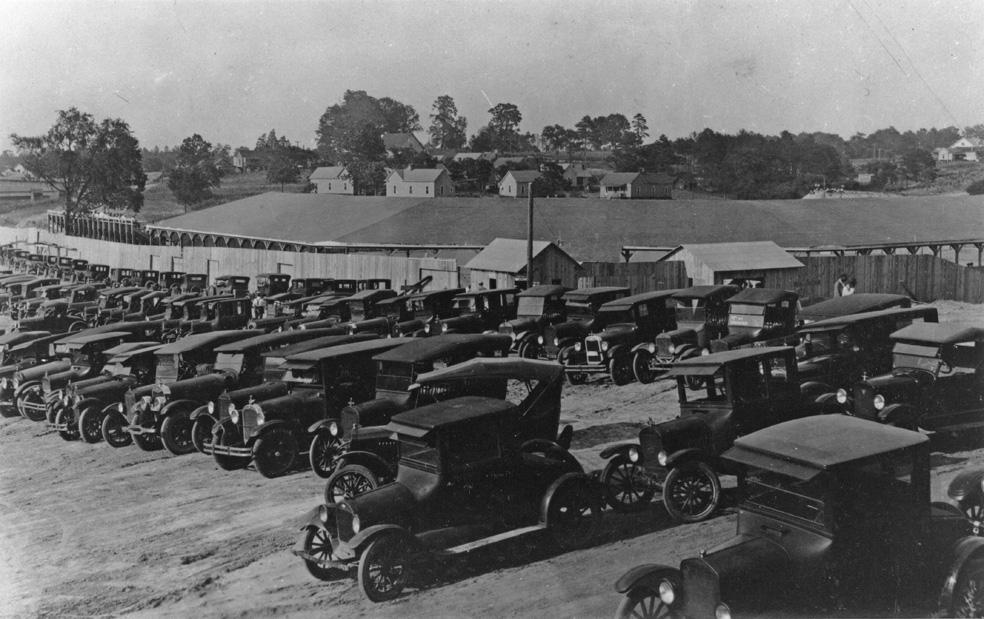
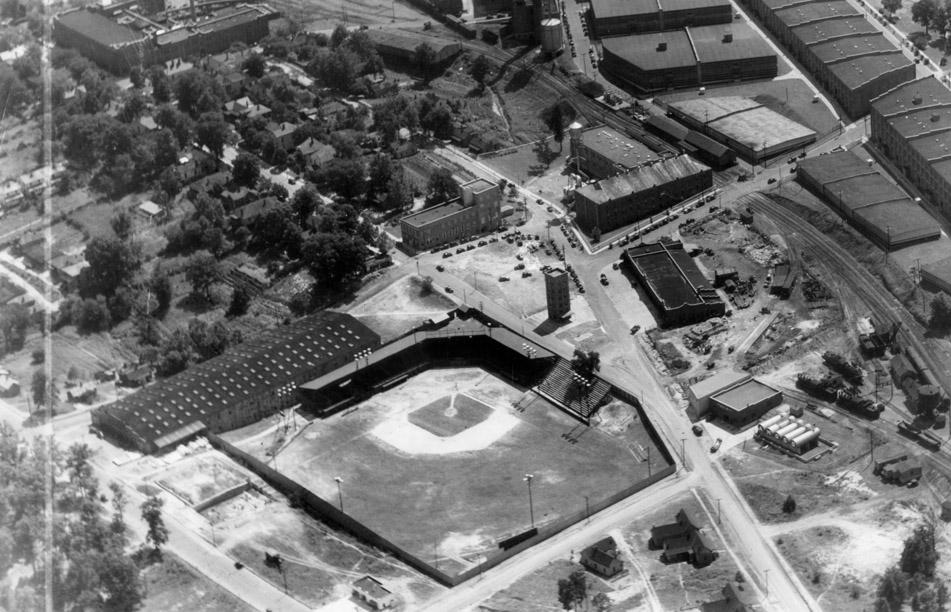
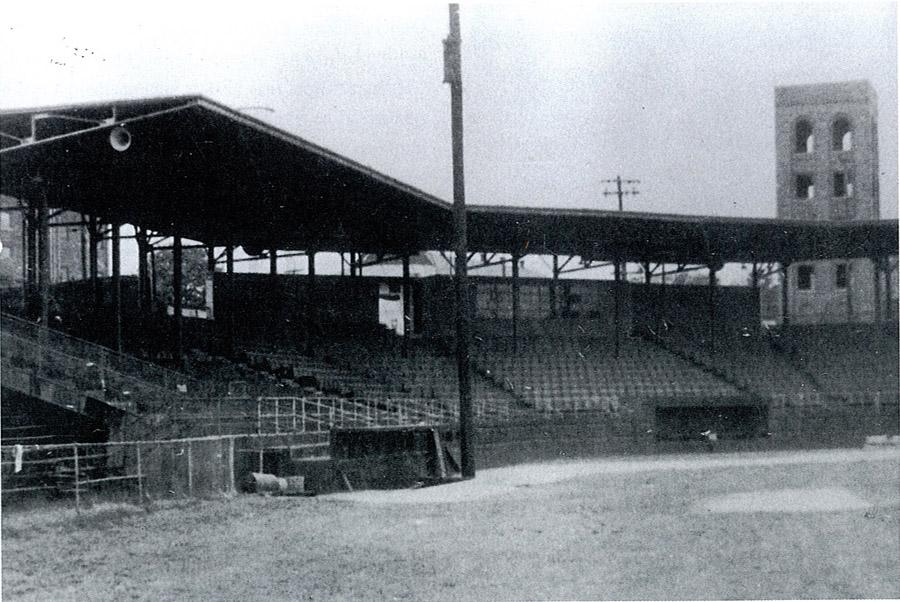
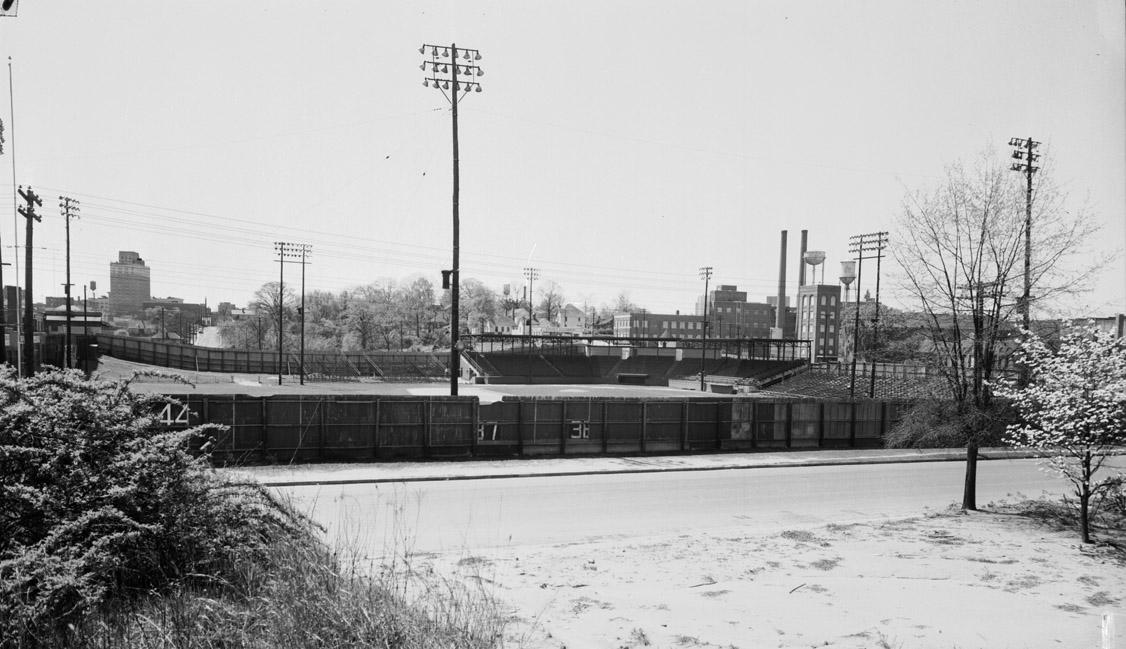
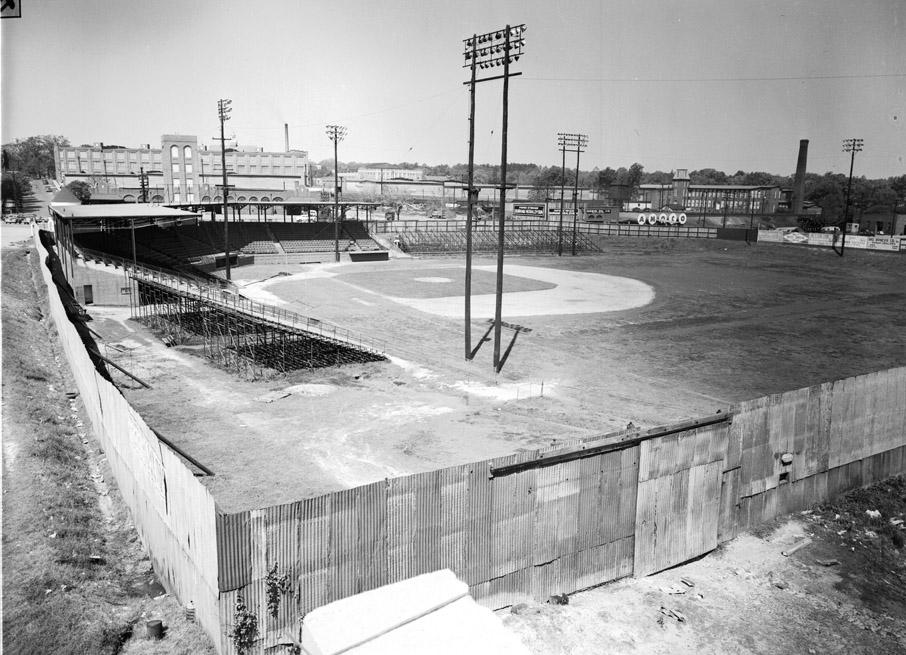
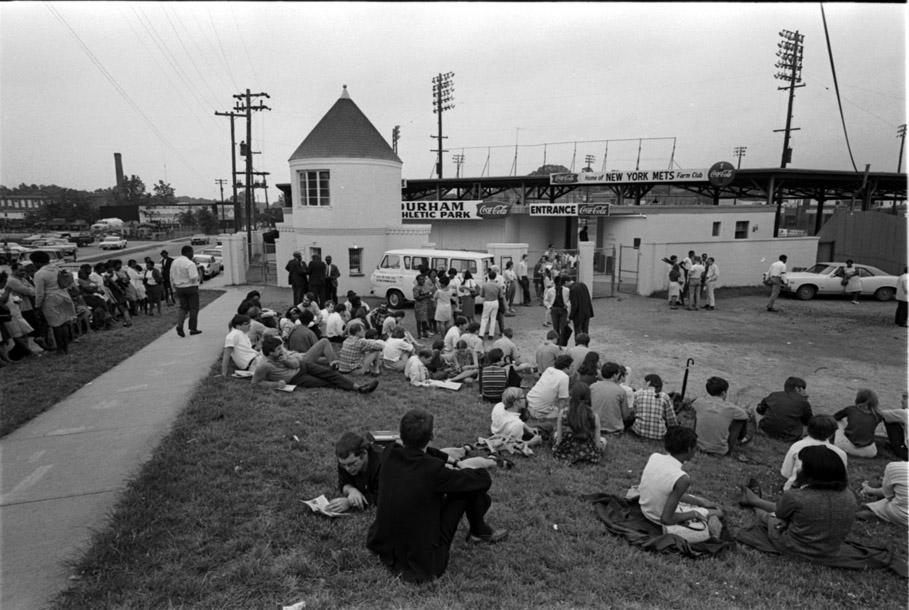
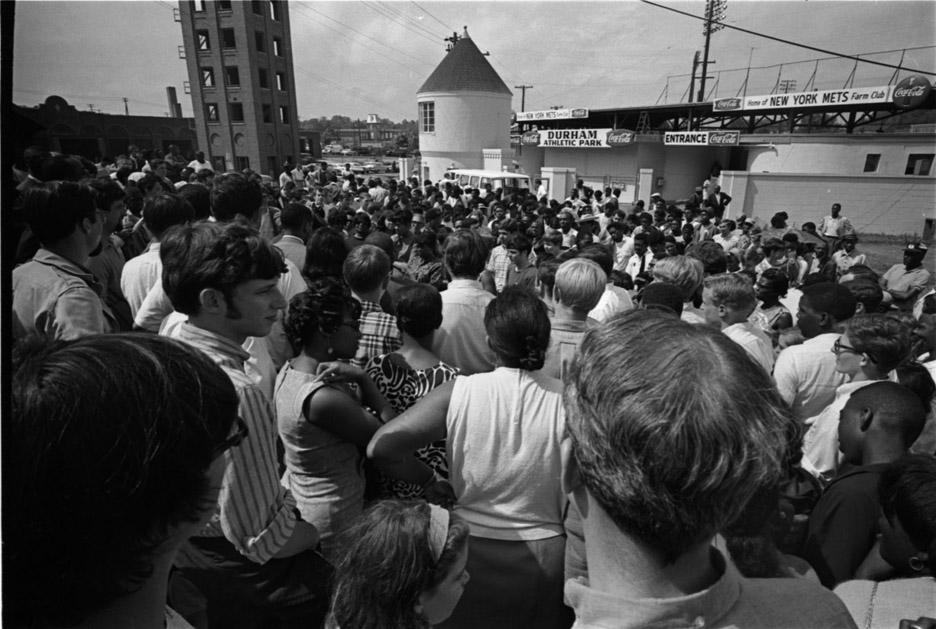
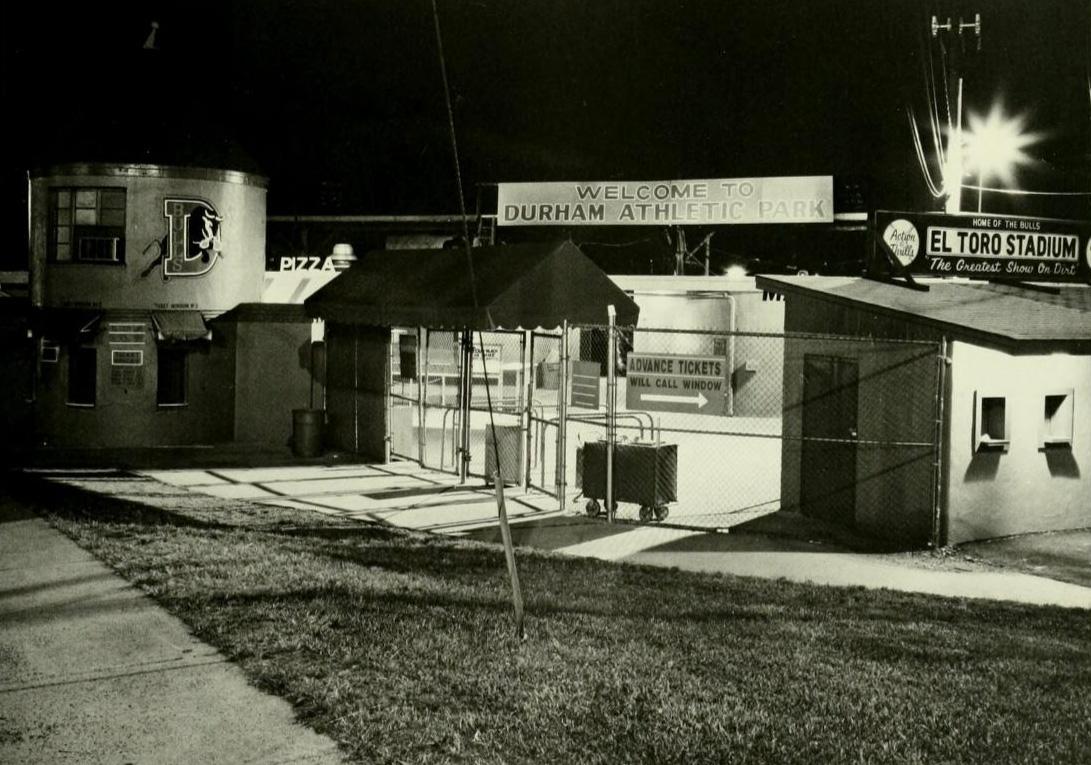
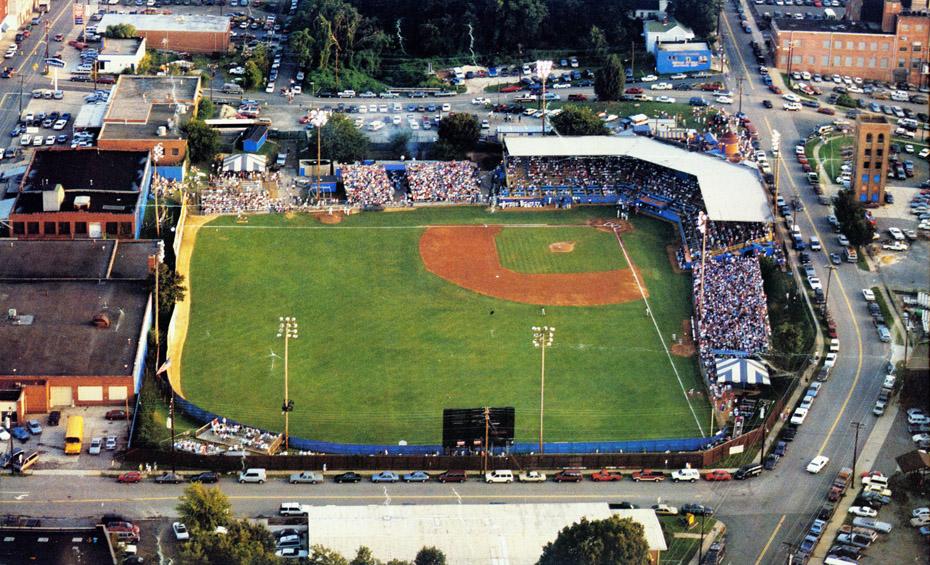
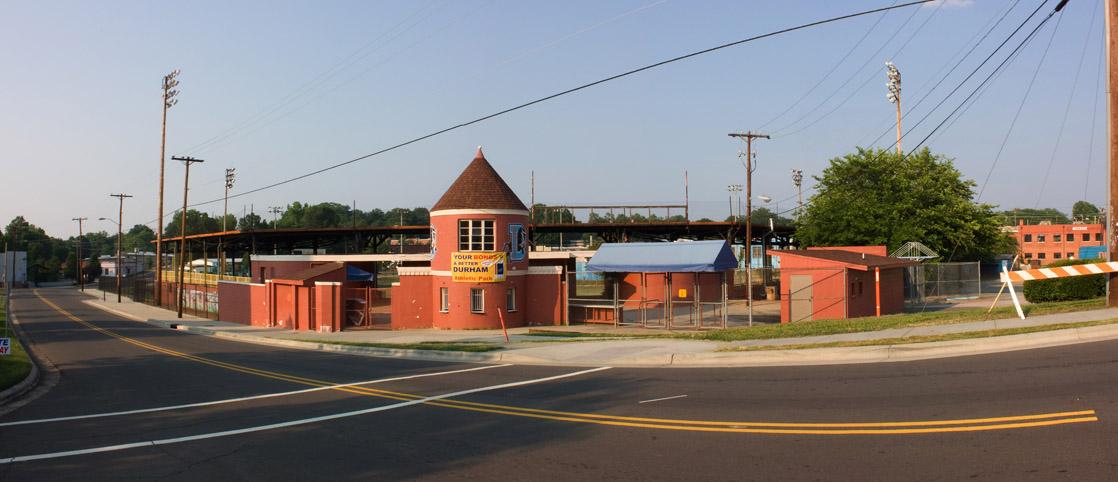
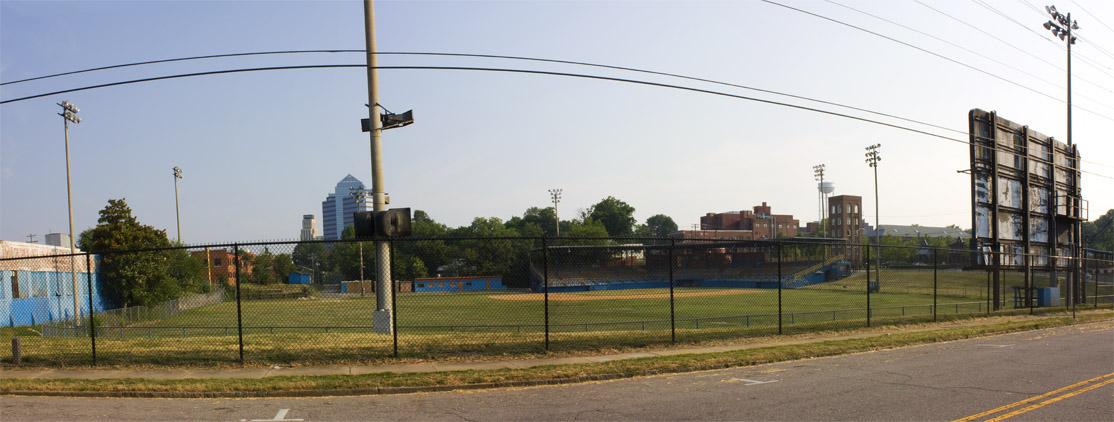
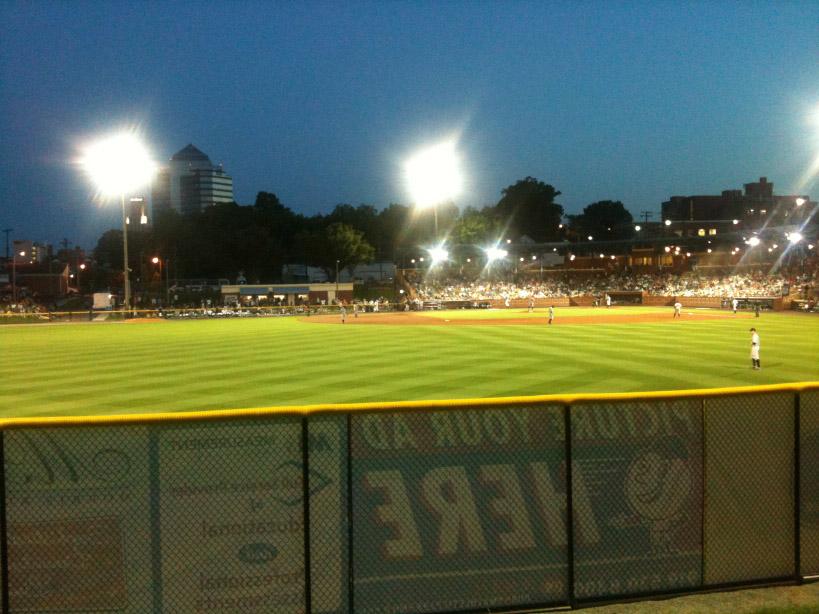
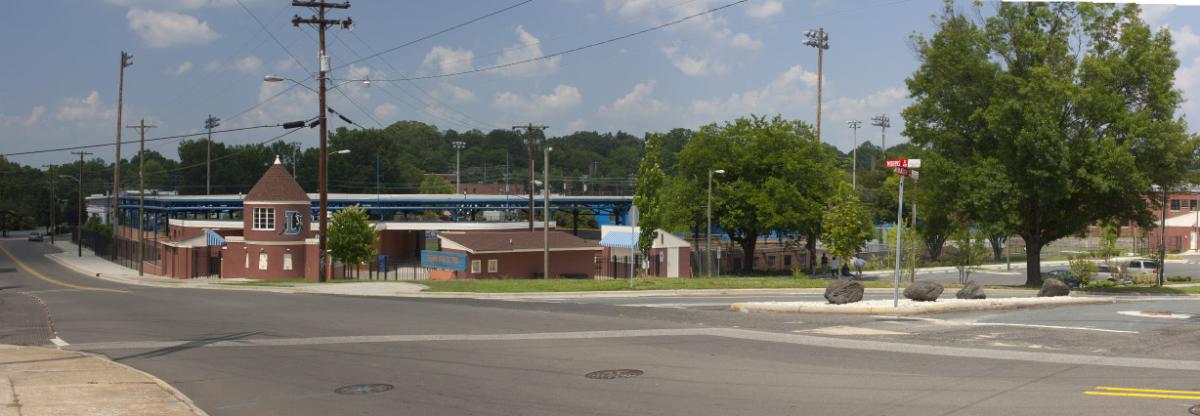
Comments
Submitted by Jon (not verified) on Fri, 6/27/2008 - 1:58pm
The popularity of the DAP for a eclectic variety of events shows how valuable a large space is to Durham. The ball games, Beer Festival, Blues Festival, etc. all contribute mightily to the Durham quality of life. I hope the new and improved DAP continues to be a venue for these events.
As an avid softball/baseball player, a highlight for me was the opportunity to play softball at the DAP for one season in the City league. Sitting in the dugouts, running the bases, and standing on the pitcher's mound were once in a lifetime experiences. I'll always remember playing on a field with such a rich history.
I wish the City softball league could have games there more often, but I know it will be hard given the field's popularity.
Final editorial note: If the DBAP was built with City tax dollars, how come it seems to be for the exclusive use of the Bulls? There are a few, minor events held there (like the recent Boy Scout campout). But why not at least play the the SDLL, NDLL, and City softball league championship games there? The players and their families would love it!
Submitted by Anonymous (not verified) on Fri, 6/27/2008 - 3:04pm
Gary -- Incredible post, and wonderful job here.
FWIW, though the Goodmon-Brier Creek story of the Bulls is often told, it's not to my understanding the only subtext. A group of Raleigh investors and business owners worked very hard trying to persuade Goodmon to move the team all the way to downtown Raleigh, where local boosters wanted to build a minor league/AAA-style park that could be expanded to major league size once Raleigh qualified for the big leagues.
A big part of these machinations was the approx. 30-mile rule that prevents teams from being located too close in proximity to each other. (Which is why the Mudcats are out in Zebulon, not closer in to Raleigh.)
According to my sources, Goodmon was very amenable to making the move to Raleigh -- until Durham leaders basically built the ballpark and gave him nearly-free use of it, at which point he reportedly said to the Raleigh boosters that basically it was too good a deal to pass up.
Which indeed it was.
Submitted by Michael Bacon (not verified) on Fri, 6/27/2008 - 3:21pm
One aspect of Durham's baseball story that I knew nothing about until recently was the presence of three different Negro Leagues teams at various points. To their credit, the Bulls do an annual "" REL="nofollow">Negro League night" where they invite former Durham players still living in the area to come sign autographs during a game.
Submitted by Joseph H. (not verified) on Fri, 6/27/2008 - 3:22pm
I'd love it if the DAP were re-re-named "El Toro Field" or the like. It'd help with the current confusion between the names for the DAP and the DBAP, and it sounds cooler too, plus it ties in some history.
The thing that worries me: now that Jim Goodmon owns the Bulls, he can eventually do whatever he likes with them.
Submitted by Gary (not verified) on Fri, 6/27/2008 - 3:30pm
Michael
I'll embarrassedly note my ignorance on Durham's Negro League teams - completely uncovered in the ~10 sources I looked at for this post. I'll get up to speed and update.
GK
Submitted by Anonymous (not verified) on Fri, 6/27/2008 - 5:00pm
Great Post, I have been waiting for this one.
In your research did you find any pictures of the park in the final days? early 90s or late 80s? the filming of Bull Durham? I think it'd be cool to see it in production that fall.
Thanks for yet another great post
Submitted by John Schelp (not verified) on Fri, 6/27/2008 - 7:08pm
Long-time Durham resident, Artis Plummer, played for the Cleveland Buckeyes in the Negro League. He also played for the Durham Eagles, Cincinnati Crescent, Cleveland Buckeyes and the Atlanta Black Crackers.
Plummer told me that Major League baseball was integrated because the Negro League was beginning to outsell the White leagues. He mentioned a game between New York and San Francisco in NYC that brought in 25,000 fans. The next day, the NY Black Yankees played his team at the same field -- in front of 35,000 fans. (Plummer owns much of Marvin's Alley, the inspiration for John D. Loudermilk's song, "Tobacco Road.")
I've always understood that while the Durham "Tobacconists" were established in 1902, the "Durham Bulls" were not created until 1913. (Perhaps the Bulls organization wanted to sneak in a couple extra years to market their big centennial a little early.) :)
Baseball games took place on both sides of Broad Street. The Tobacconists, and later the Bulls, played at Hanes Field at Trinity College. Named after the underwear family, the location is now the field hockey field on East Campus. Trinity Prep School was just north of here in Bivins Hall (so the ball field could have been considered at the northern edge of campus at the time).
Baseball games were also played across the street at the ball field run by Erwin Mills (now the Whole Foods shopping center). Home plate was about where Mad Hatter's is today. Many Saturday night dates took place watching the mill team play, in the bleachers at Broad & West Main.
Sports were very popular community activities, and competition was fierce. Cotton mill companies were not above recruiting worker-players from other mills. According to his granddaughter, Erwin Mills even recruited Italian stonecutter, Giovanni Marzocchi, to play on their team -- after finishing his work on Duke Chapel.
Here's a photograph of an early Erwin Mills team... http://www.owdna.org/History/history3.htm
Durham history is full of connections. :)
Submitted by Anonymous (not verified) on Sat, 6/28/2008 - 8:30pm
This blog is 100% awesome, I read it every day now. Mr. Endagered Durham, this is great!
Submitted by Edgemont (not verified) on Sun, 6/29/2008 - 1:20pm
Terrific blog, Gary. Absolutely wonderful job!!! Kudos!!!! I miss the old DAP and the memories it brought back. Growing up in the 50's and early 60's, as kids we used to walk to the ballpark from our homes in the edgemont area and met kids from other places in town, Braggtown, Lakewood, Oak Grove, Lowes Grove and even Forest Hills. Seems there were more afternoon games back then, which was more enjoyable for us since that allowed us to be back home before dark, or at least 9PM. I went in the Air Force in 1963 and did not move back to Durham til 1991. Didn't fully understand what had happened to Durham until I ran up on this blog. Urban Renewal, didn't understand it, but you have made me more aware of what terrible waste of time, money, and resources, not counting the fact the loss of the culture of the city it managed to destroy. I eagerly anticipate the next new posting. I check back two and three times a day to see if anything new is up. Thanks again.
Submitted by Barry (not verified) on Sun, 6/29/2008 - 9:22pm
I made it to Durham in 1993, in time to catch the final season at the DAP, and then the Second Annual final season at the DAP in 1994, when construction of the new ballpark was delayed.
My kids, who were then 4 and 9, got to climb the stairs up behind the bull in right field on numerous occasions and flip the switch that made the bull's eyes light up, or the lever that worked his tail whenever the Bulls scored a run.
My personal favorite memory of the DAP was when the Colorado Silver bullets, a touring women's professional baseball team, came to town for a game against an All-Star team of local semi-pros. It took about 5 innings before the Bulls announcer acknowledged the overwhelming attendance that day, thanking all of the members of "the Triangle chapter of the K. D. Lang Fan Club" for coming out to the game.
There was also a story that appeared in Sports Illustrated at the time the DAP closed which, unfortunately, i can't find online anywhere. As i recall it though (and i can't remember the names of the players involved either) there was a pitcher on the Bulls in the 40s who, upon his death, had his ashes worked into the pitcher's mound. One of the pitchers on the Bulls roster in 1994 was his grandson, and the SI writer evoked the image, compelling if you're a baseball fan, and perhaps disturbing if you're not, of the young man digging his cleats into the clay around the mound, picking up clumps of dirt mixed with the remains of his grandfather.
I may have the hard copy in a box somewhere.
Submitted by Jon (not verified) on Mon, 6/30/2008 - 1:09am
Beautiful blog, and what an outstanding post! I attended the Negro League Night at the DBAP earlier this month. It was a thrill to meet and get autographs from a dozen former Negro Leaguers who still reside in the Durham area. Most of them played for the Durham Rams, Colts, and/or Eagles. One of them commented to me that Durham's Negro League teams were indeed outdrawing the white teams in Durham. He said his team played at the DAP. He also said there was a historic integrated game (played at DAP?) between the Negro League team and I presume the Bulls. Attendance was overflowing and the game went off peacefully.
Submitted by Durham Central… (not verified) on Mon, 6/30/2008 - 3:09am
The other less honorable side of the story of the DAP that I just now remembered (and don't have a hard source for -- maybe John has one) was that the bleachers out in center field, that are sort of just across the street from the King's parking lot and were a beloved "cheap seat" section in the latter days of the DAP, were originally -- you guessed it -- the "negro" section of the ball park. The old entrance is said to have been off of Foster St. My best guess is that it was the walkway between the Tellard Supply building and the Brame (Cadillac) building, but it also might have been between Tellard and Nu Tread.
I don't know at what point the stands would have been integrated.
Submitted by John Schelp (not verified) on Mon, 6/30/2008 - 1:54pm
DCM, the history of the center field seats doesn't surprise me.
Duke football stadium also had a black section (in the cheap seats near the end zone; where visiting team fans now mostly sit).
Click here for a better view... http://www.dclibrary.net/prod1/ncc/schelp/js111.htm
Submitted by Michael Bacon (not verified) on Tue, 7/1/2008 - 5:19pm
Heh -- looks like I forgot to log out of the DCM Google account. That was me, for what it's worth.
Submitted by Jerry (not verified) on Thu, 12/20/2012 - 5:24am
I believe that the Carolina League was a class B league
when the Bulls were a Detroit Farm team.
I do not remember any seats being in center field in the
40s & 50s. Their were two sets of bleachers along the
right field line. The second set was the "colored section"
and had a seperate entrance behind them in right field.
Submitted by rayparrish on Mon, 8/12/2013 - 3:56pm
Test comment
Submitted by Jerry (not verified) on Wed, 12/26/2012 - 6:06am
Played football on field for Durham High. Also played on field for
Carr Jr. High.
In late 70s - early 80s football was also played on field by
local youth athletic associations.
Submitted by Andrew Edmonds on Mon, 9/28/2020 - 10:26am
With regards to the DAP used as a football field, you can clearly see the 10-yard lines drawn in this NCDOT aerial image from November 3, 1959: https://services.arcgis.com/NuWFvHYDMVmmxMeM/arcgis/rest/services/MyMED_1950/FeatureServer/0/3047/attachments/3044
The 1959 DHS team went 4-6. Maybe one of these wins occured a few days after the photo was taken. https://lib.digitalnc.org/record/35281?ln=en#?c=0&m=0&s=0&cv=143&r=0&xywh=1710%2C325%2C4543%2C2761
Submitted by Rick Duke (not verified) on Wed, 12/26/2012 - 11:35am
The team of the late 60's, preceding the Triangles was the Phillies ( arm team of Philadelphia) -- not the Mets,. I'm a 100% certain of that since I went to some of those games, and remember a guy named Greg Luzenski who played here. UNC also played a season there in the early 70's while Boshamer Field was being upgraded. We use to hang out near the home dugout and make concession stand runs for the players prior to game starts. Tips were pretty good.
Submitted by Jerry on Tue, 9/29/2020 - 11:59am
!959 DHS team was first team to play at new County Stadium.
1958 DHS team would have played at DAP.
Submitted by Jerry on Tue, 9/29/2020 - 12:04pm
On second thought 60 team may have been first at county stadium.
Add new comment
Log in or register to post comments.